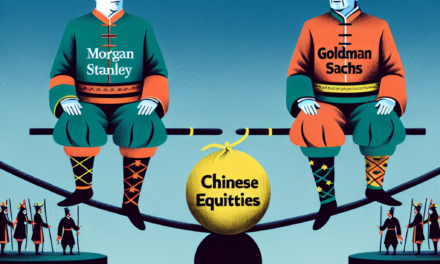“Unlock Potential: Discover the Digital Bank Stock Outshining SoFi!”
Introduction
In the rapidly evolving landscape of digital finance, investors are constantly on the lookout for promising opportunities that offer both innovation and growth potential. SoFi, a well-known player in the fintech space, has garnered significant attention with its diverse range of financial products and services. However, as the market becomes increasingly competitive, discerning investors might wonder if there are other digital banking stocks that could offer even greater returns. This article explores whether it might be prudent to look beyond SoFi and consider investing in a digital bank stock that stands out for its exceptional performance, strategic vision, and potential for long-term growth.
Evaluating The Growth Potential Of Digital Banks
In recent years, the financial landscape has been dramatically transformed by the rise of digital banks, which have emerged as formidable competitors to traditional banking institutions. Among these digital disruptors, SoFi has garnered significant attention due to its innovative approach and comprehensive suite of financial services. However, investors seeking to capitalize on the growth potential of digital banks may find themselves pondering whether to focus on SoFi or consider other promising contenders in the sector. One such alternative that merits consideration is a digital bank that has been quietly but steadily gaining traction, offering a compelling case for investment.
To begin with, the digital banking sector is characterized by its rapid evolution and the ability to adapt to changing consumer preferences. This adaptability is crucial in an era where convenience, speed, and user-friendly interfaces are paramount. While SoFi has made significant strides in capturing market share, it is essential to evaluate other digital banks that are leveraging technology to enhance customer experience and expand their offerings. One such digital bank has distinguished itself through its strategic focus on niche markets and innovative product development, positioning itself as a formidable player in the industry.
Moreover, the growth potential of digital banks is intrinsically linked to their ability to scale operations efficiently. This particular digital bank has demonstrated a robust growth trajectory, underpinned by its strategic partnerships and collaborations with fintech companies. These alliances have enabled the bank to integrate cutting-edge technologies, such as artificial intelligence and blockchain, into its operations, thereby enhancing its competitive edge. In contrast, while SoFi has also embraced technological advancements, the bank in question has shown a remarkable ability to leverage these technologies to streamline processes and reduce operational costs, ultimately driving profitability.
Furthermore, regulatory compliance is a critical factor that can significantly impact the growth prospects of digital banks. The digital bank under consideration has proactively engaged with regulatory bodies to ensure compliance with evolving financial regulations. This proactive approach not only mitigates potential risks but also fosters trust among consumers and investors alike. While SoFi has similarly prioritized regulatory compliance, the bank in question has established a reputation for its transparent and ethical business practices, which could prove advantageous in the long term.
In addition to regulatory compliance, customer acquisition and retention are pivotal to the sustained growth of digital banks. The digital bank in question has implemented a customer-centric approach, focusing on personalized services and tailored financial solutions. This strategy has resulted in a loyal customer base and high retention rates, which are indicative of the bank’s ability to meet the diverse needs of its clientele. Although SoFi has also prioritized customer satisfaction, the bank in question has excelled in creating a seamless and engaging user experience, which is crucial in an increasingly competitive market.
In conclusion, while SoFi remains a prominent player in the digital banking sector, investors should not overlook the potential of other digital banks that are making significant strides in the industry. By evaluating factors such as technological innovation, regulatory compliance, and customer-centric strategies, it becomes evident that this particular digital bank offers a compelling investment opportunity. As the financial landscape continues to evolve, the ability to adapt and innovate will be key determinants of success, making this digital bank a worthy contender for those seeking to invest in the future of banking.
Comparing SoFi And Its Competitors In The Fintech Space
In the rapidly evolving fintech landscape, investors are constantly on the lookout for promising opportunities that can yield substantial returns. SoFi Technologies, Inc., a prominent player in this space, has garnered significant attention due to its innovative approach to personal finance and its comprehensive suite of financial products. However, as the fintech sector continues to expand, it is crucial to consider whether SoFi is the best investment choice or if there are other digital bank stocks that might offer superior potential.
To begin with, SoFi has made a name for itself by offering a wide range of financial services, including student loan refinancing, personal loans, mortgages, and investment products. Its user-friendly platform and focus on millennials and Gen Z have contributed to its rapid growth. Moreover, SoFi’s acquisition of a banking charter has enabled it to offer more competitive rates and expand its product offerings. Despite these advantages, investors should not overlook the competitive pressures SoFi faces from other fintech companies and digital banks.
One such competitor is Square, Inc., which has rebranded itself as Block, Inc. Square has established a strong foothold in the digital payments space with its Cash App, which has become a popular tool for peer-to-peer transactions, investing, and even cryptocurrency trading. The company’s strategic acquisitions and partnerships have further strengthened its position in the market. Additionally, Square’s focus on small businesses through its point-of-sale systems and financial services has diversified its revenue streams, making it a formidable competitor to SoFi.
Another noteworthy contender in the digital banking arena is PayPal Holdings, Inc. PayPal has long been a leader in online payments, and its recent ventures into the digital banking space have been met with enthusiasm. The company’s Venmo app, similar to Cash App, has gained significant traction among younger users. PayPal’s global reach and established brand reputation provide it with a competitive edge, allowing it to expand its offerings and capture a larger share of the market.
Furthermore, investors should consider the rise of neobanks, which are digital-only banks that operate without physical branches. Companies like Chime and N26 have been gaining popularity due to their low fees, user-friendly interfaces, and innovative features. These neobanks have been particularly successful in attracting younger customers who prefer digital-first solutions. As these companies continue to grow and expand their services, they pose a significant threat to traditional banks and established fintech firms like SoFi.
In light of these considerations, it is essential for investors to conduct thorough research and evaluate the competitive landscape before making investment decisions. While SoFi has demonstrated impressive growth and innovation, the fintech space is highly dynamic, with new entrants and established players constantly vying for market share. By examining the strengths and weaknesses of SoFi’s competitors, investors can make more informed choices about where to allocate their resources.
Ultimately, the decision to invest in SoFi or another digital bank stock should be based on a comprehensive analysis of each company’s financial health, growth prospects, and competitive positioning. As the fintech industry continues to evolve, staying informed about market trends and emerging technologies will be crucial for investors seeking to capitalize on the opportunities presented by this exciting sector.
Key Factors To Consider When Investing In Digital Bank Stocks
When considering investments in digital bank stocks, it is crucial to evaluate several key factors that can significantly influence the potential success of your investment. As the financial landscape continues to evolve with technological advancements, digital banks have emerged as formidable players, challenging traditional banking institutions. While SoFi has garnered considerable attention in this sector, it is essential to explore other promising digital bank stocks that may offer substantial growth opportunities. To make informed investment decisions, one must delve into the critical aspects that define the potential of these digital banks.
First and foremost, the technological infrastructure of a digital bank is a fundamental factor to consider. A robust and scalable technology platform is essential for digital banks to efficiently manage operations, enhance customer experience, and introduce innovative financial products. Investors should assess whether the digital bank has invested in cutting-edge technology that can support its growth ambitions. This includes evaluating the bank’s ability to leverage artificial intelligence, machine learning, and data analytics to offer personalized services and streamline operations. A digital bank with a strong technological foundation is better positioned to adapt to changing market dynamics and customer preferences.
In addition to technology, regulatory compliance is another critical consideration. The financial industry is heavily regulated, and digital banks must adhere to stringent regulatory requirements to ensure their operations are secure and transparent. Investors should examine whether the digital bank has a comprehensive compliance framework in place and whether it has a track record of adhering to regulatory standards. A bank that prioritizes compliance not only mitigates legal risks but also builds trust with customers and investors alike.
Furthermore, the competitive landscape is an important aspect to evaluate when investing in digital bank stocks. The digital banking sector is highly competitive, with numerous players vying for market share. Investors should analyze the bank’s competitive positioning and its ability to differentiate itself from rivals. This involves assessing the bank’s unique value proposition, customer acquisition strategies, and brand strength. A digital bank that can effectively carve out a niche in the market and attract a loyal customer base is more likely to achieve sustainable growth.
Moreover, financial performance and growth prospects are paramount when considering digital bank stocks. Investors should scrutinize the bank’s financial statements to assess its profitability, revenue growth, and cost management. A digital bank with a strong financial track record and a clear path to profitability is more likely to deliver long-term value to shareholders. Additionally, understanding the bank’s growth strategy, such as plans for geographic expansion or the introduction of new products, can provide insights into its future potential.
Lastly, the management team plays a pivotal role in the success of a digital bank. A competent and visionary leadership team can drive innovation, navigate challenges, and execute the bank’s strategic vision effectively. Investors should evaluate the experience and track record of the bank’s executives, as well as their ability to adapt to the rapidly changing financial landscape.
In conclusion, while SoFi is a prominent player in the digital banking sector, investors should not overlook other digital bank stocks that may offer compelling investment opportunities. By carefully considering factors such as technological infrastructure, regulatory compliance, competitive positioning, financial performance, and management expertise, investors can make informed decisions and potentially capitalize on the growth prospects of a magnificent digital bank stock.
The Future Of Banking: Digital Banks Vs. Traditional Banks

In recent years, the banking industry has witnessed a significant transformation, driven by the rapid advancement of technology and the evolving preferences of consumers. This shift has given rise to digital banks, which are increasingly challenging the dominance of traditional banks. As investors seek opportunities in this changing landscape, the question arises: should one ignore popular digital banking platforms like SoFi and instead consider investing in other promising digital bank stocks?
To understand the potential of digital banks, it is essential to first examine the factors contributing to their rise. Digital banks, also known as neobanks, operate primarily online without the need for physical branches. This model allows them to offer lower fees, higher interest rates on deposits, and a more seamless user experience compared to traditional banks. The convenience of managing finances through a smartphone app, coupled with the ability to access a wide range of financial services, has made digital banks particularly appealing to tech-savvy consumers and younger generations.
Moreover, digital banks have been quick to adopt cutting-edge technologies such as artificial intelligence and machine learning to enhance their services. These technologies enable them to offer personalized financial advice, detect fraudulent activities more efficiently, and streamline customer service through chatbots and virtual assistants. As a result, digital banks are not only meeting the current demands of consumers but are also well-positioned to adapt to future trends in the financial sector.
While SoFi has garnered significant attention as a leading digital banking platform, it is not the only player in the market. Investors should consider other digital bank stocks that may offer substantial growth potential. For instance, some digital banks have focused on niche markets, such as small business banking or international money transfers, allowing them to carve out a unique position in the industry. By targeting specific customer segments, these digital banks can differentiate themselves from competitors and build a loyal customer base.
Furthermore, the regulatory environment is evolving to accommodate the rise of digital banks. Governments and financial authorities are increasingly recognizing the importance of fostering innovation in the banking sector while ensuring consumer protection. This shift in regulatory attitudes is likely to benefit digital banks, as it provides them with a more favorable operating environment and the opportunity to expand their services.
In contrast, traditional banks face several challenges in adapting to the digital age. Their legacy systems and extensive branch networks often hinder their ability to innovate and compete with more agile digital banks. Additionally, traditional banks must contend with the high costs associated with maintaining physical infrastructure and complying with stringent regulations. These factors can limit their ability to offer competitive rates and services, potentially leading to a decline in market share.
In conclusion, the future of banking is undoubtedly leaning towards digital solutions, driven by consumer demand for convenience, personalization, and innovation. While SoFi remains a prominent player in the digital banking space, investors should not overlook other digital bank stocks that may offer unique advantages and growth opportunities. By carefully evaluating the strengths and strategies of various digital banks, investors can make informed decisions that align with the evolving landscape of the financial industry. As the competition between digital and traditional banks intensifies, those who embrace the digital revolution are likely to emerge as leaders in the future of banking.
Analyzing The Financial Performance Of Leading Digital Banks
In recent years, the financial technology sector has witnessed a remarkable transformation, with digital banks emerging as formidable players in the industry. Among these, SoFi has garnered significant attention due to its innovative approach and diverse range of financial products. However, as investors seek to capitalize on the burgeoning digital banking market, it is crucial to evaluate the financial performance of leading digital banks to make informed investment decisions. While SoFi’s growth trajectory is impressive, there is another digital bank that warrants consideration for its exceptional financial performance and potential for long-term growth.
To begin with, SoFi has made substantial strides in expanding its customer base and product offerings. The company’s focus on providing a comprehensive suite of financial services, including loans, investment options, and insurance, has positioned it as a versatile player in the digital banking space. SoFi’s ability to attract a younger demographic, particularly millennials and Gen Z, has been a key driver of its growth. Moreover, its strategic acquisitions and partnerships have further bolstered its market presence. However, despite these achievements, investors must consider the financial metrics that underpin SoFi’s operations to assess its sustainability and profitability.
In contrast, another digital bank has demonstrated remarkable financial performance, making it a compelling alternative for investors. This bank has consistently reported strong revenue growth, driven by its innovative business model and customer-centric approach. Unlike SoFi, which has diversified its offerings, this digital bank has focused on optimizing its core banking services, resulting in a leaner and more efficient operation. By leveraging cutting-edge technology and data analytics, it has been able to streamline processes, reduce costs, and enhance customer experience, thereby achieving higher profit margins.
Furthermore, this digital bank’s prudent risk management strategies have contributed to its financial stability. While SoFi has ventured into riskier lending segments, this bank has maintained a conservative approach, focusing on creditworthy customers and minimizing default rates. This strategy has not only safeguarded its financial health but also instilled confidence among investors. Additionally, its robust capital position and strong liquidity ratios underscore its ability to weather economic uncertainties and sustain growth in the long term.
Another aspect that sets this digital bank apart is its commitment to innovation and technological advancement. By continuously investing in research and development, it has introduced cutting-edge features and services that cater to evolving customer needs. This forward-thinking approach has not only enhanced customer satisfaction but also driven customer loyalty, resulting in a steady increase in its user base. In contrast, while SoFi has made strides in technology adoption, its focus on diversification may dilute its efforts in delivering specialized banking solutions.
Moreover, this digital bank’s strategic expansion into international markets presents a significant growth opportunity. By tapping into underserved regions and leveraging its technological expertise, it has been able to capture new customer segments and diversify its revenue streams. This global expansion strategy not only mitigates risks associated with domestic market saturation but also positions the bank for sustained growth in the future.
In conclusion, while SoFi remains a prominent player in the digital banking sector, investors should not overlook the financial performance and growth potential of this magnificent digital bank. Its focus on core banking services, prudent risk management, commitment to innovation, and strategic global expansion make it a compelling investment opportunity. As the digital banking landscape continues to evolve, making informed investment decisions based on comprehensive financial analysis will be crucial for investors seeking to maximize returns in this dynamic sector.
Understanding The Risks And Rewards Of Digital Bank Investments
Investing in digital banks has become an increasingly popular option for those looking to capitalize on the rapid evolution of financial technology. As traditional banking institutions face mounting pressure to innovate, digital banks are emerging as formidable competitors, offering streamlined services and enhanced customer experiences. However, with this burgeoning sector comes a complex landscape of risks and rewards that investors must carefully navigate. While SoFi has garnered significant attention as a prominent player in the digital banking arena, it is crucial to consider whether other digital bank stocks might offer more compelling investment opportunities.
To begin with, the allure of digital banks lies in their ability to leverage technology to reduce operational costs and offer competitive rates and services. This efficiency often translates into higher profit margins and the potential for rapid growth, making digital banks attractive to investors seeking high returns. Moreover, the increasing consumer preference for online and mobile banking solutions further bolsters the growth prospects of digital banks. As more individuals and businesses transition to digital platforms, these banks are well-positioned to capture a larger market share.
However, investing in digital banks is not without its risks. The sector is characterized by intense competition, with numerous players vying for dominance. This competitive environment can lead to aggressive pricing strategies and increased marketing expenditures, which may erode profit margins. Additionally, digital banks must continuously innovate to stay ahead of technological advancements and changing consumer preferences. Failure to do so could result in a loss of market relevance and a decline in customer base.
Regulatory challenges also pose a significant risk to digital banks. As these institutions operate in a highly regulated industry, they must navigate complex legal frameworks that vary across jurisdictions. Compliance with these regulations can be costly and time-consuming, potentially impacting profitability. Furthermore, any changes in regulatory policies could adversely affect the operations and growth prospects of digital banks.
Despite these challenges, the potential rewards of investing in digital banks are substantial. For instance, some digital banks have successfully differentiated themselves by focusing on niche markets or offering unique value propositions. These banks often enjoy strong customer loyalty and can achieve sustainable growth by catering to specific customer needs. Additionally, digital banks that prioritize data security and privacy can build trust with their customers, further enhancing their competitive advantage.
In light of these considerations, investors may wonder whether they should overlook SoFi in favor of other digital bank stocks. While SoFi has established itself as a leader in the sector, it is essential to evaluate its performance and growth potential relative to its peers. Investors should conduct thorough due diligence, examining factors such as financial health, market positioning, and strategic initiatives. By doing so, they can identify digital banks that offer a more attractive risk-reward profile.
Ultimately, the decision to invest in SoFi or another digital bank stock should be based on a comprehensive analysis of the risks and rewards associated with each option. By understanding the unique dynamics of the digital banking sector, investors can make informed decisions that align with their investment goals and risk tolerance. As the financial landscape continues to evolve, those who carefully assess the opportunities and challenges within the digital banking space are likely to reap the benefits of this transformative industry.
How Technological Innovations Are Shaping The Digital Banking Industry
In recent years, the digital banking industry has undergone a remarkable transformation, driven by technological innovations that are reshaping how financial services are delivered and consumed. As traditional banks grapple with the challenges of modernizing their operations, digital banks are leveraging cutting-edge technologies to offer seamless, efficient, and customer-centric services. This evolution is prompting investors to reconsider their portfolios, often leading them to question whether they should ignore popular stocks like SoFi in favor of other promising digital banking stocks.
One of the most significant technological advancements influencing the digital banking sector is the rise of artificial intelligence (AI) and machine learning. These technologies are enabling digital banks to offer personalized financial advice, automate customer service through chatbots, and enhance fraud detection mechanisms. By analyzing vast amounts of data, AI systems can provide insights into customer behavior, allowing banks to tailor their offerings to individual needs. This level of personalization not only improves customer satisfaction but also fosters loyalty, a crucial factor in the competitive banking landscape.
Moreover, blockchain technology is making waves in the digital banking industry by offering a secure and transparent way to conduct transactions. The decentralized nature of blockchain reduces the risk of fraud and enhances the speed of transactions, making it an attractive option for digital banks aiming to streamline their operations. As blockchain continues to gain traction, digital banks that integrate this technology into their platforms are likely to gain a competitive edge, attracting both customers and investors.
In addition to AI and blockchain, the proliferation of mobile technology has been a game-changer for digital banks. With the majority of consumers now owning smartphones, digital banks are focusing on creating intuitive and user-friendly mobile applications. These apps allow customers to perform a wide range of banking activities, from checking account balances to applying for loans, all from the convenience of their mobile devices. The emphasis on mobile technology not only enhances accessibility but also aligns with the growing demand for on-the-go banking solutions.
Furthermore, the integration of open banking is another technological innovation that is transforming the digital banking industry. Open banking allows third-party developers to build applications and services around a financial institution, providing customers with more choices and better financial products. This innovation fosters a more competitive environment, encouraging digital banks to continuously improve their offerings to retain and attract customers. As open banking becomes more prevalent, digital banks that embrace this trend are likely to see increased customer engagement and growth.
While SoFi has made significant strides in the digital banking space, it is essential for investors to consider other digital bank stocks that are capitalizing on these technological innovations. Companies that are at the forefront of adopting AI, blockchain, mobile technology, and open banking are well-positioned to thrive in the evolving financial landscape. By focusing on these technological advancements, investors can identify digital bank stocks that offer not only growth potential but also resilience in the face of industry disruptions.
In conclusion, technological innovations are playing a pivotal role in shaping the digital banking industry, offering new opportunities for both banks and investors. As AI, blockchain, mobile technology, and open banking continue to redefine the sector, it is crucial for investors to stay informed and consider stocks that are leveraging these advancements. While SoFi remains a popular choice, exploring other digital bank stocks that are embracing these technologies may lead to more rewarding investment opportunities in the long run.
Q&A
1. **Question:** What is the main focus of the article?
– **Answer:** The article focuses on comparing SoFi with another digital bank stock to determine which might be a better investment.
2. **Question:** What are the key strengths of SoFi mentioned?
– **Answer:** SoFi’s key strengths typically include its comprehensive financial services platform, strong customer growth, and innovative technology offerings.
3. **Question:** What are the potential weaknesses or risks associated with investing in SoFi?
– **Answer:** Potential weaknesses might include regulatory challenges, competition in the fintech space, and profitability concerns.
4. **Question:** What is the “magnificent digital bank stock” being compared to SoFi?
– **Answer:** The article likely identifies a specific digital bank stock that is considered a strong investment alternative to SoFi, such as a well-established fintech company.
5. **Question:** What are the advantages of the alternative digital bank stock over SoFi?
– **Answer:** Advantages might include a stronger financial position, better growth prospects, a larger customer base, or superior technology.
6. **Question:** How does the market performance of the alternative stock compare to SoFi?
– **Answer:** The article would compare recent stock performance, highlighting whether the alternative has outperformed SoFi in terms of stock price appreciation or stability.
7. **Question:** What is the final recommendation of the article regarding investment?
– **Answer:** The article likely concludes with a recommendation on whether investors should consider the alternative digital bank stock over SoFi based on the analysis provided.
Conclusion
When considering whether to ignore SoFi in favor of another digital bank stock, it’s important to evaluate key factors such as financial performance, growth potential, market position, and innovation. If the alternative digital bank demonstrates stronger financial health, a robust growth trajectory, a competitive edge in technology or services, and a solid market presence, it may be a more attractive investment. However, investors should also consider their risk tolerance and investment goals. Ultimately, the decision should be based on a comprehensive analysis of both companies’ prospects and alignment with the investor’s strategy.





